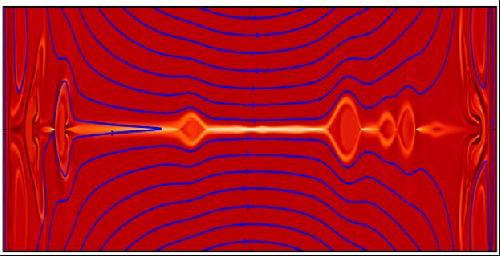Magnetic reconnection, which occurs when magnetic lines of force break apart and reconnect with a violent burst of energy, gives rise to many beautiful and powerful phenomena in the natural world. These include solar flares, the Northern Lights, and geomagnetic storms that can disrupt cell-phone service or knock out power grids. Scientists have long known that the Sweet-Parker model typically used to describe magnetic reconnection was unable to explain the speed at which it operates. Now, researchers have gone beyond the framework of that model to include new mechanisms that speed up reconnection, providing new insights into the process.
At the U.S. Department of Energy's Princeton Plasma Physics Laboratory (PPPL), researchers found that the Sweet-Parker model itself is flawed. To solve the problem, the researchers turned their attention to plasmoids--instabilities that occur in plasma containing the reconnecting lines of force--as the possible cause of fast reconnection (Figure 1). These instabilities take place very rapidly and change the predictions described by the Sweet-Parker model.
The new model predicts a novel regime in which the fast reconnection rate appears to be independent of the resistivity--or resistance to electrical current--of the system. "This fundamental discovery has attracted a great deal of interest from theorists as well as experimentalists in laboratory and space plasma physics," said Amitava Bhattacharjee, head of the Theory Department at PPPL. Bhattcharjee will present the findings in a talk to the 57th annual meeting of the American Physical Society-Department of Plasma Physics in Savannah, Georgia.
 Model of a current sheet of plasma with magnetic field lines that are ready to reconnect showing plasmoid instabilities in the center of the sheet. Credit: Courtesy of Yi-Min Huang.
Model of a current sheet of plasma with magnetic field lines that are ready to reconnect showing plasmoid instabilities in the center of the sheet. Credit: Courtesy of Yi-Min Huang.
This new nonlinear model was developed by Bhattacharjee and Yi-Min Huang, a research scholar in Princeton University's Department of Astrophysical Sciences. The model is based on an earlier model of the linear instability by Nuno Loureiro, a former post-doctoral fellow at PPPL. Loureiro now heads the Theory and Modeling Group at the Institute for Plasmas and Nuclear Fusion in Lisbon and will receive the Thomas H. Stix Award for Outstanding Early Career Contributions to Plasma Physics Research at the APS meeting.
source: American Physical Society